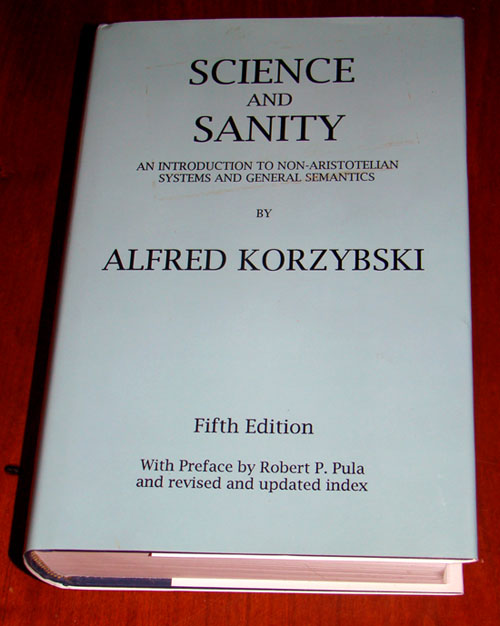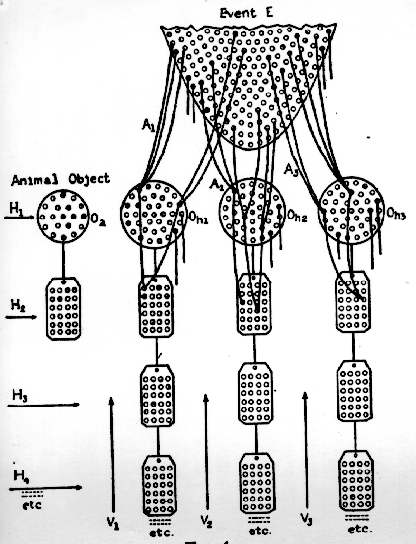E-Prime and the Structural Differential (A Refresh on General Semantics)

E-Prime is a version of English that eliminates forms of the verb to be as means to clarify thinking, avoid fallacies, bias and misconceptions and strengthen writing. It was devised as an adjunct to Korzybski’s general semantics in the late 1940’s. Particularly the verb’s function in cases of assigning identities and essences (“is of Identity” and “is of Predication”) gets emphasized as forming pernicious thinking habits (and thus epistemological consequences as well as psychological ones) in how things are commonly articulated within the syntactical arrangements and implicit order of language (subject-predicate constructions, sequential linearity, causal inversions, etc.)
Avoiding usage of the verb whenever possible is suggested, substituting instead with other linking verbs and constructions.
To Be or Not to Be: e-Prime as a Tool for Critical Thinking (David Bourland)
The 10 page paper is available here.
As we become conscious of our misunderstandings we improve the quality of our thinking, and most particularly, of thinking about thinking, which Richard Paul defines as “critical thinking.”
[…]
The verb “to be” carries with it a huge intellectual momentum of completeness, finality, and time independence.
The Impact of E-Prime on Writing and Talking
In this part of the paper I will present four of the major consequences of using E-Prime in written and spoken utterances.
- Vanishing Questions. One simply cannot ask a number of questionssome would say pseudo-questions-that have preoccupied many people . What is man? What is woman? Is it art? What is my destiny? Who am I? Such questions, by virtue of their semantic structure, set the stage for identifications and confusions in orders of abstraction. They tend to lead to discourse in which the likelihood of useful information generation or exchange declines precipitously. One might better ask questions on a lower order of abstraction such as these: What characterizes man or woman uniquely? In what way can I relate to this art form, if any? What can I do now to improve my future possibilities? May I have another drink?
- Vanishing Internal Instructions. Various schools of psychotherapy have recognized the importance of the silent assumptions which we hold about the world and ourselves . Other schools, especially the “rational therapy” developed and practiced by Dr . Albert Ellis, also recognize the importance of what we tell ourselves, vocally and sub-vocally. “Self-suggested nonsense ;” Dr. Ellis calls this in its undesirable forms . Most of us have encountered people whose life patterns have decayed as they keep repeating to themselves such comments as these: “I am a failure, consequently . . .” “I am a success, therefore . . :” “She is a Catholic, so . . :” “He is a Jew, hence . . :” “I am a teacher, so what I am doing must be teaching” “Since I am the head of this household . . .”
- Abbreviations. Forms of “to be” encourage and indeed facilitate the making of abbreviated statements that may turn out to convey little or no information, although we often behave as if they do . For example, we often see such empty comments as : “It is clear that . . .” “Well, business is business.” “The problem is just a matter of semantics :” Let us discuss that last assertion. While of course most human problems involve important (and usually unexplored because unperceived) semantic issues, these issues do not evaporate just because someone has labelled them thusly . Some people use “It’s just semantics” as an analysis stopper. One might productively respond to such a comment by pointing out, “Certainly ; at least in part . Now let’s try to clarify some of those semantic problems.”
Structural Differential
A three-dimensional model illustrating the abstracting processes of the human nervous system that is used as a training device in general semantics.

The device is intended to show that human “knowledge” of, or acquaintance with, anything is partial and circumstantial - not total and static/unchanging. It illustrates how we extract what we know (in the form of how we can know it) from what we see in an imperfect representation of the underlying dynamics of reality in perpetual motion and constant change.
The structural differential consists of three basic objects:
- Parabola: Represents a domain beyond our direct observation, the sub-microscopic, dynamic world of molecules, atoms, electrons, protons, quarks, and so on; a world known to us only inferentially from science. Korzybski described it as an ‘event’ in the sense of “an instantaneous cross-section of a process.” Thus the ‘event’ or parabola represents the sub-microscopic ‘stuff’ that, at any given moment, constitutes an apple. In other words, the parabola represents the “external” cause of what we experience.
- Disc: Represents the non-verbal result of our nervous systems reacting to submicroscopic “stuff”, e.g., the apple that we see, hold, bite into, all on the non-verbal levels of experience. The disc represents what we experience of our surroundings versus what our surroundings actually are.
- Labels: Tags representing the static world of words, e.g., “apple”, giving imperfect accounts of dynamic reality. An object called an “apple” left in a jar for months becomes a putrid liquid (because of its underlying, dynamic, sub-microscopic structure), but the label “apple” does not change. The word “steak”, at a lower verbal order, may imply “something to eat” at a higher verbal order, but in the sub-microscopic domain, a particular steak may be contaminated with poisons created by harmful bacteria that we could see only on microscopic levels.
The holes in the figures represent the characteristics that exist at each level. The characteristics that are abstracted to the next level are indicated by the attached strings. The strings that don’t make it to the next level represent characteristics left out of our abstractions, as do the holes without strings at all. More is left out of our abstractions at each level than was there at the previous level.

Thus the differential sets up a hierarchy of order, with the submicroscopic domain of dynamic change coming first, the relatively stable universe conveyed non-verbally by our senses coming next, and then the verbal levels. A label is what we attach to a non-verbal experience in order to identify this experience in verbal terms; when we identify an “apple”, we attribute to this identification various non-verbal experiences.

From the patent.
